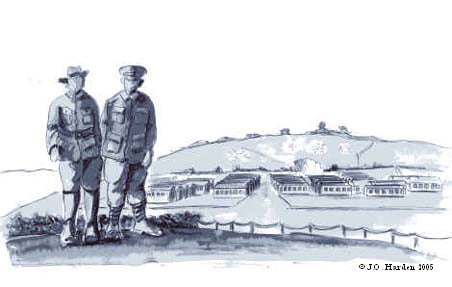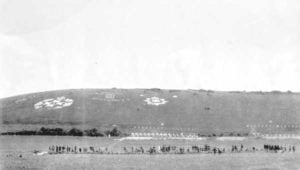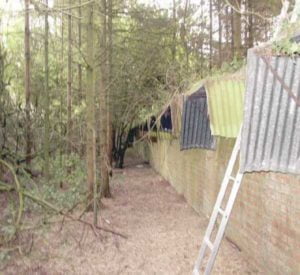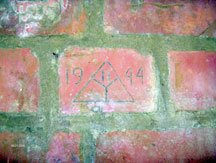
Fovant Rifle Range graffiti.
Introduction
Considering it is over 60 years since the graffiti artists of the 1940’s left their marks on the walls and corrugated metal shelters of ‘The Butts’, much is still visible. Several FHIG members have carried out much hard work on the deciphering and listing of the names, including unit and home information, and the position of the soldier’s handiwork.
The majority of the graffiti is the work of American soldiers and at the end of this page is a list of some of these men and from where in America they came. We also have some information on ranks and service numbers all of which is now in the FHIG database. A handful of British soldiers, from the Royal Welsh Fusiliers and the Oxford and Buckinghamshire Light Infantry, also left their mark and we hope to have more information regarding these soldiers soon. Gill Nevill is using the recorded data to trace the actual soldiers or their friends and relatives who may have written, photographed or talked about their experiences in and around Fovant during and after WW II. In due course any new data will be recorded here.
The Rifle Range
 Fovant Rifle Range is now disused, but was one of two ranges associated with the extensive camps present during World War I. The accompanying photograph taken about that time shows that the westernmost range was below the badge of the Devonshire Regiment cut into the hillside. The butts that are still evident are located between the OS map references SU 0129 2812 and SU 0125 2801 and lie in the direction 198 degrees (grid). They are approximately 390 feet long of which 60 ft constitutes the target store located at the south-west end. Clearly there was a toilet block at the north-east end.
Fovant Rifle Range is now disused, but was one of two ranges associated with the extensive camps present during World War I. The accompanying photograph taken about that time shows that the westernmost range was below the badge of the Devonshire Regiment cut into the hillside. The butts that are still evident are located between the OS map references SU 0129 2812 and SU 0125 2801 and lie in the direction 198 degrees (grid). They are approximately 390 feet long of which 60 ft constitutes the target store located at the south-west end. Clearly there was a toilet block at the north-east end.
The present remains look to be more recent than the WW I period and it is almost certain that the installation was refurbished or rebuilt for WW II. The remaining structure seems to be a typical example of military butts in that it constitutes a trench of about 7 ft deep and 16 ft wide, faced on the firing side with an earth bank and brick wall. The toilet and store include breeze block construction.
 The wall side has some corrugated iron roofing supported on iron brackets (82 of them). About half of the roofing has become bent to form what appears to be a series of shelters corresponding to the target positions, but this may just be due to natural collapse. At the foot of the brick wall is a 5 ft wide concrete pavement and roughly in the centre of the butts is evidence of a telephone shelf, with a one-pair protected cable going up the wall, and an iron pipe which may have been used to hold a flag pole, the flag being used to signal when firing could take place.
The wall side has some corrugated iron roofing supported on iron brackets (82 of them). About half of the roofing has become bent to form what appears to be a series of shelters corresponding to the target positions, but this may just be due to natural collapse. At the foot of the brick wall is a 5 ft wide concrete pavement and roughly in the centre of the butts is evidence of a telephone shelf, with a one-pair protected cable going up the wall, and an iron pipe which may have been used to hold a flag pole, the flag being used to signal when firing could take place.
It is not known when Fovant Rifle Range was taken out of use. It appears on the list of lapsed Byelaws published on the Defence Estate web site, but the MOD do not hold copies of those byelaws. Judging from the fir trees which have been planted, in at least two straight lines, along the butts, the range cannot have been in use for the past twenty or thirty years.
The butts are on private land and we are grateful to Mr Edward Williams of East Farm, Fovant, for permission to explore them.
US Army units
It is known that the following US Army units were present in the area during WW II:
Dinton Park
- 4 Base Air Depot. 9th US Army Air Force (AAF number 802)
- Battery C, 455th AAA (Anti-Aircraft Artillery)
- 433 Engineer Dump Truck Company
Fonthill Park
- 55 Armored Infantry Battalion. 11 Armored Division. (Thunderbolt).
Grovely Woods
- 1512 Quartermaster Truck Battalion 1968 QM Trk Co
- 1961 Ordnance Depot Company
- 2056 Quartermaster Company Truck Aviation
These and the 433 Engineer Dump Truck Company were all Afro-American units, the US Army being segregated at the time.
The Graffiti
Not all of the graffiti has yet been recorded. Some of it is inscribed on the brick work and some on the iron roofing. Much of it is very difficult to read, so the table below must contain a certain amount of inaccuracy.
There has also been some duplication as each of us has attempted to interpret the graffiti. There is a column in the table which shows where duplication has occurred.
| Svc No. | Forenames | Surname | Rank | Unit | Home | Date | Duplicate? |
|---|---|---|---|---|---|---|---|
| R.W.F. | |||||||
| R.E. | |||||||
| 11 Armd Div (Badge) | |||||||
| RWF | Aberyst(wyth?) | ||||||
| (STAR OF DAVID) | |||||||
| Wales | |||||||
| Eugene ? | Yes | ||||||
| Smudge | Redcar, Yorks | ||||||
| S.C. | Andrews | Yes | |||||
| SC (?) | Andrews | SC (?) | Yes | ||||
| AW | 01/04/41 | ||||||
| Ballard | Detroit, Mich | Yes | |||||
| Yesse | Ballard | Detroit, Michigan | Aug 1943 | Yes | |||
| CF | Bell | Yes | |||||
| CF | Bell ?? | Yes | |||||
| Claud H. | Berryhill | Cpl | |||||
| BR | |||||||
| S | Brereton | Burslem | |||||
| Dick | Brescher | (TWICE) | Wellis (Wells?), Minnesota | ||||
| 31364406 | Tony | Canzano | Law, Mass | ||||
| GE | Carter | Cpl | Gol(d)sboro, NC | ||||
| W.J. | Carter | GA | |||||
| L | Celta | Lawrence, Mass | |||||
| Reno ? | Cyic ?? | Yes | |||||
| Reno ? | Cyig | Yes | |||||
| H | Davies | ||||||
| AW | Decker | Maywood, ML (IL) | |||||
| Walter | Denton | Denton ? | |||||
| 36238581 | Roman | Dietzen | Appleton, Wis | ||||
| Bob | Ditt(oe) | ||||||
| Doherty | Boston | ||||||
| 37732983 | Eugene | Eastley | KC, Mo | Yes | |||
| ER | |||||||
| 35290974 | Richard | Feath(er) | APO 230 793 (?) | ||||
| 32165065 | John | Fedorchak | Passiac, (Passaic) NJ | Yes | |||
| John | Fedorchak | Fass Cinci | Yes | ||||
| Feloncha | |||||||
| 37788745 | David | Frank | Iowa | 03/01/44 | Yes | ||
| 20744245 | David | Frink | Iowa | 03/01/44 | Yes | ||
| Frint | |||||||
| Ted | Garboski | Mahwah, NJ | 6/?/1944 | ||||
| L | Garmen | ||||||
| Gibbens | L/C | Glosters | Bristol | ||||
| Tommy | Gilbert | AP ? | |||||
| 36037125 | Ivan | Goff | APO 253 | Robinson, Ill | |||
| Pat | Gran….nico | NYC | 15 Sept 1943 | Yes | |||
| 12058113 | Pat | Grandonico | NYC | 15/09/43 | Yes | ||
| FS | Gymon | Oklahoma | |||||
| 37726941 | Don | Hadlock | |||||
| AL | Hale | ||||||
| 34213811 | Ernest | Hardee | USA | Yes | |||
| Hargreaves | Guisburo(ugh), Yorks | ||||||
| LK | Hart | Ind | |||||
| 34213811 | Ernest | Haydee | Andrews, SC | Yes | |||
| 33816252 | AB | Heitz | Becca ?? Penn | ||||
| V | Hembrow | ||||||
| Don | Hendix | Shoronville, Ohio | March 1944 | Yes | |||
| 35796631 | Don | Hendrix | Sharonville, Ohio | March 44 | Yes | ||
| 38303915 | M | Hillin | W Texas | ||||
| Cary | Hodkin | Oxf & Bucks ? | |||||
| Hoggat | |||||||
| R | Hunter | Co C 55th Armd Ind Bn | |||||
| Joe | Hyde | Topeka, Kans | |||||
| F | Hyne | ||||||
| 15068078 | Homer M. | Initt | Sud.ett, Kentucky | Yes | |||
| M.M | Innes | Bristol | Yes | ||||
| Jelloohen | Manor Penna JJ (Penn) | 23/10/43 | |||||
| L | Jones | Tenn | |||||
| M.M | Jones | Cfn | Yes | ||||
| MM | Jones | Cfn | Yes | ||||
| 36378559 | Neil | Kerner | Newton, Ill | ||||
| 37408740 | Charles T | Kirkhart | St Louis, Mo | ||||
| K | Klutz | Cinn | |||||
| 13054130 | R | Le Coney | |||||
| Walter | Lech | Co C 27 AD INF Bt APO 259 | |||||
| Lloyd | |||||||
| Manuel | Martin | Taujilla ? New Mexico | |||||
| Glenn | Matson | ||||||
| John | McCarty | ||||||
| Woody | McKeithan | Yes | |||||
| Woody | Mckeithen | Yes | |||||
| F | McKenna | ||||||
| Lith | Meyer | 55 AIB | Lucky, Ohio | ||||
| 35643333 | Homer | Mim | Sgt | Kentucky | Yes | ||
| Homer | Min?? | Sgt | Sud?nette, Kentucky | Yes | |||
| Henry L | Molemore | Yes | |||||
| Henry L. (?Hendy) | Molemore | Yes | |||||
| Bill | Moore | Pvt | Columbus, Ohio | ||||
| H | Moore | Ohio | |||||
| 32407223 | M | Morroch | 11 AD (Small badge) | 27/04/05 | |||
| 15329538 | Frank | Mucciacito | Tiffh Ohio (Tiffin?) | ||||
| LP | Neaster | Ohio | |||||
| Earney L | Newton | Omaha, Neb | |||||
| Norwalk | Conn | ||||||
| Parish | Phla | Yes | |||||
| Parrish | Florida | Yes | |||||
| 36038596 | A | Pezze | Yes | ||||
| Pezzea | Yes | ||||||
| ?Tim | Pezzea | Yes | |||||
| 31064167 | Leo | Plourde | Bristol, Conneticut | ||||
| 37771500 | Mick | Prescher | Minnesota | ||||
| 36129981 | F | Rankin | Detroit, Mich | ||||
| PT | Reid | ||||||
| R | Rennikley | ||||||
| Reno | |||||||
| 35515971 | A. | Ronges | Cleveland, Ohio | ||||
| A | Ronkilla | Gilbert Minnisota | |||||
| Leo | Rourde? | Bristol Conn | |||||
| 35333279 | Schult | Tolrom? Ohio | |||||
| G. | Shelley | Waukegan, Ill. | |||||
| EL | Sirovy | Minn | |||||
| 37550564 | Skiba | Minn | |||||
| 20128066 | Smey | Cpl? | Conn? | ||||
| Geo | Spahn | Dennison, Louisiana | 2 March 1944 | Yes | |||
| George | Spahn | APO 230 | Denison Iowa | 02/03/44 | Yes | ||
| Steve | Stoddard | ||||||
| Cecil | Strom | Yes | |||||
| Cecil | Strong | Yes | |||||
| John H | Taylor | Co D 81st Tk | |||||
| 37679766 | Tonne | Rock Rapids, Iowa | |||||
| Roy | Trammell | Memphis, B868, Texas | |||||
| FC | Urfer | Wynne, Ark | 01/07/45 | ||||
| Valencia | PFC | from Texas | |||||
| VWP | Portsmouth, VA | ||||||
| Walter | |||||||
| Watken | |||||||
| WF | Ox & Bucks LI (Badge) | Aug 43 | |||||
| 33495479 | EH | Whire | Harrisburg | ||||
| AC | Wilkins | Pvt | Hayesville, VA | 26/02/44 | |||
| Will | |||||||
| Varne | Williams | Kendrick City, Tennessee | 7 April 1944 | Yes | |||
| Varnell | Williams | Lenoir City, Texas (TN) | 04/07/44 | Yes | |||
| 38218526 | Jack | Wilson | Dallas, Texas | Yes | |||
| Jack | Wilson | Dallas | Yes | ||||
| Wimit | |||||||
| Ed | Wojjecki. | Pvt | Chicago, Boyg | ||||
| A | Wooton | Pvt | 39th Coy GC | Yes |
Unit identification
Clearly, most of the soldiers identified with their home towns rather than their units, but we were fortunate in R. Hunter, who not only identified his battalion, but also his company; Lith Meyer confirmed the battalion and George Spahn and others have inscribed APO numbers which were Army Post Offices for troops in the European Theatre. Furthermore someone had also engraved his divisional sign, as shown below. The actual sign is shown alongside the photograph and more details of this division can be found at their web site.
Briefly, the Division arrived in the UK in October 1944 and left for France in December to form part of Lt General George S. Patton Jr’s 3rd Army. They were hastily moved to Belgium and first saw action around Bastogne during Hitler’s last throw of the dice in the German thrust through the Ardennes, often known as the ‘Battle of the Bulge’. As an Armored Infantry Battalion it would be inevitable that the maintenance of their small arms skills would be given a high priority. Hence their presence at a Rifle Range. The other units in the area would be classed nowadays as performing a logistics role, both for the ground troops and for the 9th Air Force, which in WW II was part of the US Army (hence US A AF). Even so, it is disappointing that we have so far found no evidence of those units.
Two entries remain a puzzle – Walter Lech’s entry of CnC 27 AD INF Bt could be Company C, but the 27th Armored Infantry Battalion was part of the 9th Armored Division which is not known to have been in our area, although it achieved lasting fame by being the first allied unit to cross the Rhine. If the battalion was nearby, it would have used the range between September and December of 1944 and interestingly, it seems to have been first involved in combat on 18th December 1944 which coincides with the Battle of the Bulge to which the 11th Armored Division was also rushed.
A. Wooton of 39th Coy RC (or GC) could be American or British. Coy (for Company) tends to be a British abbreviation, whereas Pvt (for Private) tends to be American (the British Army uses Pte). There certainly was a 39th Company RASC which dealt with Heavy Transport but otherwise little is known of this unit.
More evidence of British Army use of the range is less obvious, but a significant piece of graffiti is in the toilet where AW thoughtfully added the date that he was there (1 April 1941). This is at least one piece of confirmation that the range was in use well before the attack on Pearl Harbor which brought the USA into WW II, always providing that AW wasn’t making April Fools of us! One other, rather tenuous, piece of evidence is the name of MM Jones who appears to have signed himself ‘Cfn’. If this has been interpreted correctly, it indicates that Cfn Jones was a Craftsman in the Royal Electrical and Mechanical Engineers (REME). Although largely a logistics outfit, REME soldiers would still have to make occasional trips to the range to preserve such firearm’s skills as they attained in Basic Training units.
Rather more definite is Lance-Corporal Gibbens who signed himself as a Bristolian in the Glosters. The rank and the use of the short name of the Gloucestershire Regiment seems positive identification as a Brit. Other British soldiers are Cary Hodkin and WF who were of the Ox & Bucks. A battalion of this Light Infantry regiment fought in NW Europe as part of the 53rd (Welsh) Division, so it may be that two of the inscriptions RWF could represent the Royal Welch Fusiliers who were part of the same Division. This is merely conjecture though.
The soldiers’ home states
The US Army does not, and did not, identify their infantry regiments in the same way as the British Army county regiments. Indeed, a regiment in the US Army is equivalent to a British Army brigade. It may be that battalions such as the 55th Armored Infantry were originally recruited from certain states, although their composition in a drafted wartime army would be unlikely to maintain this composition.
Map indicating where some of the soldiers came from
Future work
There are still many names to be deciphered in the butts, particularly on the overhead shelter. An attempt has been made to label the distance along the wall of the butts and our database has recorded the position of the graffiti with respect to those labels.
So far, no data has been found on the Internet giving details of the layout of a typical WW II rifle range, although we have found evidence of the foundations of the frames that were used to hold the targets, which were pretty substantial (canvas, 4 feet square, mounted on 4 x 4 ins timber).
There is evidence of the impact area behind the targets as it is still possible to pick up spent rounds on the hill side. It is also possible to see where the bullets impacted by looking at the representation of the area to be found on Google Earth
And what of the soldiers themselves, several of whom could still be alive. A memorial plaque to the 55th Armored Infantry Battalion was affixed to the Tisbury War Memorial in 2004. A description of the presentation and photographs of the unit’s soldiers is contained in ‘The Tisbook’ edited by Rex Sawyer.
Acknowledgements
Fovant History Interest Group are grateful to Mr Edward Williams for allowing the investigation to take place on his land.
The whole investigation was sparked off by previous work carried out by Mr and Mrs Nevill and we are indebted to them for prompting us into joining them in a new line of research.
The photograph of the range taken during WW I was obtained from Mr David Greenwood of the Fovant Badges Society. It was taken by someone who merely signed himself as ‘A Digger’.
Margaret McKenzie took the photograph of the Divisional insignia inscribed on the wall of the butts, under far from ideal conditions, and the coloured version of the insignia came from the 11th Armored Division web site.
Information on various US Army units came mainly from the Internet, although ‘The Tisbook’ gave considerable detail on the 55th Armored Infantry Battalion in particular.
G.N. & M.C.L.H.
September 2006
Content last updated
7 March 2008



